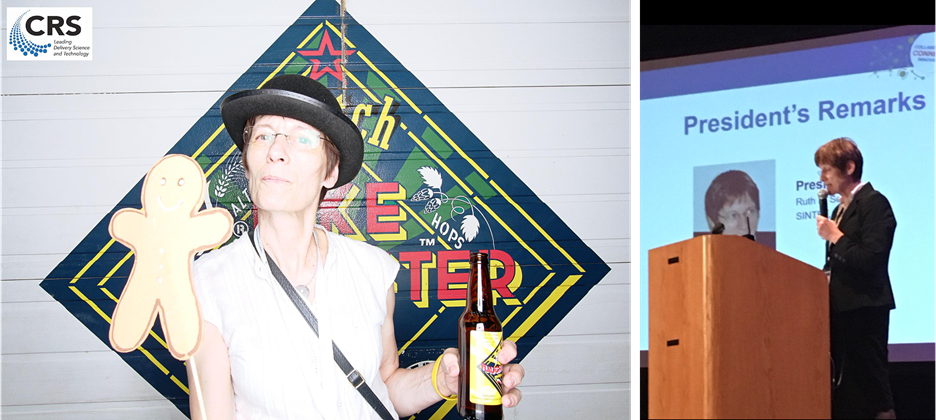
How much do you remember from your first CRS Meeting? Ruth Schmid, former CRS President and Vice President of Marketing at SINTEF Industry, remembers the extravagance of Las Vegas in 1998. “It was my first time in the US and we were running around, looking at the pirate ship and volcano,” she reminisced, acknowledging that “I don’t remember much from the actual meeting!” Over the past 25 years, Ruth has attended 22 CRS Annual Meetings and credits the events for her personal growth as a leader, her cultivation of a global scientific network, and even her idea for a recently-launched drug delivery startup. She sat down to share her reflections on what’s stayed the same at the CRS Annual Meetings, what’s changed, and what members like herself gain by returning every year.
Since the beginning, the CRS Meetings have focused on scientific dissemination through workshops, oral sessions, poster sessions, and technical exhibits. These events center recent technological developments from CRS members in academia, industry, and beyond, allowing early-career and senior researchers to learn from each other. Networking and social connections have also always been priorities, such as the welcome reception and closing dinner which have been mainstays of the Annual Meeting program.
However, most of the program and process of developing it have changed significantly over time. While the Annual Meeting Programming Committee has always led planning and organization, today the Committee engages “a much broader community,” according to Ruth, who sits on the AMPC as a liaison for the CRS Consumer Products: Delivery beyond Pharma Division. For example, each Focus Group organizes their own scientific session, including sending invited speaker suggestions, reviewing abstracts, and selecting oral presentations. Another big change is that industry is more intentionally incorporated throughout the program. “Earlier, we had the ‘Industrial Sunday,’ one day for all the technical workshops, the soapbox session, and industrial roundtable,” Ruth described. Today, industry-relevant sessions and translational projects are highlighted throughout the entire conference.
A disheartening change has been increased competition in the meeting landscape, making it challenging to attract a large number and diversity of attendees. Over the past few years, due to the pandemic and climate crisis, many universities and companies have restricted conference travel. “If I can only go to 1 conference a year, do I choose one focused on my research area, or go to a meeting like CRS which is topically broad?” Ruth knows many scientists who have made difficult choices not to attend the CRS Meeting due to policies like these. In response, CRS must demonstrate the value of scientifically broad meetings. “The multidisciplinarity of today’s global challenges,” Ruth says, requires collaboration across fields, industries, and countries.
This global network is one of the main reasons Ruth has continued to engage with CRS throughout her career. “CRS is my community,” she shares, “both the scientific network and also all the friends.” Meeting up annually has been a critical space to share ideas and build relationships. Many of her scientific projects were collaborations with other CRS scientists, and this experience is not unique in the organization. “Another thing CRS gave me was the opportunity to develop as a leader,” she continued, describing her 9 years as a Board member. “Even though I didn’t have previous experience as Secretary, or as Treasurer, they told me ‘you can learn that’ and ‘you can do that!’” The confidence and connections developed during these years influenced the trajectory of her career, and undoubtedly motivate her continued commitment to the CRS Diversified Product Division, Women in Science group, and newly the ED&I Task Force.
In the future, Ruth hopes to see an increased focus “at the interfaces.” In addition to exploring connections between academia and industry, she sees an opportunity to build bridges between pharmaceutical and non-pharmaceutical areas of CRS. For example, oral drug delivery shares many features with food additives and nutrition science; transdermal delivery is closely connected to cosmetics and fragrances. Ideally, the Annual Meeting should be a space for these scientists to meet. “Learning from each other by discussing and sharing experiences is possible at the interfaces in our organization,” she wrote during her Presidency. She also expects that CRS will need to innovate to stay globally accessible. Whether this is through making the Annual Meetings more affordable, more attractive, or creating more virtual options, accessibility will be a major challenge facing many societies in the modern era.
To those attending future Meetings, Ruth has some advice. First, “don’t sit with your colleagues!” At her first conferences, she stuck by the friends she came with and didn’t meet many others; when she attended a conference alone, she found herself outside of her comfort zone and making new friends at lunch. For early-career researchers, she recommends asking questions during the scientific sessions as one way to increase their visibility. Even if it’s a silly question (“in fact, there are no silly questions”), stand up, say your name and institution, and then ask your question. For more seasoned CRS attendees, she hopes they engage with younger scientists at the poster session: ask questions, give positive feedback, and help them build their international network. Whether it’s your first Meeting or your 23rd, the CRS community is sure to be a highlight of your trip.
Follow Ruth Schmid on Twitter (https://twitter.com/ruthbs) and LinkedIn (https://www.linkedin.com/in/ruth-schmid-92340312/). Andrea Joseph is a postdoctoral fellow at the Icahn School of Medicine at Mount Sinai (https://twitter.com/andrea_j0seph).


